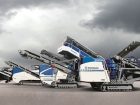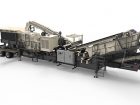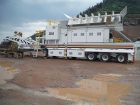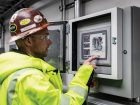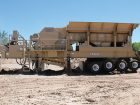
Features
Aggregates
Technology
Hybrids and automation
Producers looking to new technologies to solve a variety of challenges
June 5, 2019 By Andrew Snook
Fuel cost reductions. Improved efficiency and safety. Combatting skilled labour shortages. In Canada’s construction sector, these are some things that are always on the mind of contractors. And the world of crushing is no exception.
Aggregates operation managers are always looking for ways to combat rising fuel costs, get better returns on investment, reduce downtime, make their operations safer, and find answers to solving the issue of a shrinking and changing skilled labour pool. And the answer, more often than not, is found in the ever-evolving technologies found in the equipment.
“There’s more and more technology coming into the equipment, everything from telematics through remote monitoring to automation,” says David Quail, business line manager for Terex MPS. “All of those things that can reduce operating costs either improving uptime or from the standpoint of safety are just becoming more prevalent.”
He says that the trend over the past five years has been away from legacy relay systems and towards highly engineered automated solutions, as customers become more familiar with the newer technologies available in the marketplace.
“Not even from the standpoint of operating, but from the standpoint of diagnosing problems – troubleshooting problems, raising flags before minor problems turn into major problems – more and more, those are the kinds of questions we’re getting asked when we’re talking to customers who are really starting to understand the benefits of those systems,” he says, adding that he believes interest in newer technologies is largely being driven by a declining skill base for some producers that don’t have the operators with 20 and 30 years of experience that they had 10 years ago. “Some of the operators that come in today don’t have that experience, so they’re more and more reliant on the technology to make sure that potentially small issues aren’t allowed to develop into much larger issues.”
Metso’s vice-president of aggregates services Rick Robinson says that newer automation technologies that can be added and controlled via smartphones are in growing demand. This will be important for the younger generations coming, who are more reliant on these technologies than previous generations.
“The young people coming out of school want to work in an office and behind a computer,” Robinson says. “They’re not as interested in climbing up on equipment. They’re more interested in running the plant from behind the desk.”
“Our entire industry over the last 20 years has made a major shift from having the old dogs that carried the wrenches and knew when the machine was working right and were able to perform periodic maintenance on the machines. All of that is going away,” adds Mike Schultz, impact crushing product manager for Superior Industries. “As that labour force decreases and diminishes, especially the experience within that labour force, that’s when things like automation and the fact that we’re building failure prediction models that will tell you when you’re having a problem or when you could potentially have a problem, simply by gathering data for the machine, that’s when it’s going to pay dividends for the end user at the end of the day. As we move forward as an industry into the modern era where things like this are going to become more prevalent and more technology is going to be involved, I think we will attract more younger people into our industry.”
ELECTRIC SOLUTIONS
Hybrid technologies have been getting increased attention from crushing operations, particularly diesel-electric combinations. Kolberg-Pioneer Inc. introduced a mobile track product last ConExpo with hybrid power sourcing.
“It’s definitely something that’s going to be more and more popular on both coasts where we’re having permitting issues,” says Tim Harms, sales engineer at Kolberg-Pioneer Inc. “You can literally run these mobile tracked units with line power or with an onboard diesel engine. The innovation there is that this truly is sharing the same drive components. Everything was kept the same internally… the same hydraulic motor that was on a conventional crusher would used on the hybrid unit.
“In the simplest terms, we can either put power into one side or the other of our drive arrangement for our hydraulic pumps, so there’s an electric-operated clutch there that disengages the engine if the electric power is going to be used. That’s an extremely simple definition, but that’s basically what we’re doing, so that provides a tremendous amount of flexibility.”
KPI is currently working on several models of the mobile track units with four different engine size packages: 7-litre, 9-litre, 13-litre and 15-litre.
Daryl Todd, president of Frontline Machinery, a Chilliwack, B.C.-based mobile heavy equipment provider of heavy equipment including the Keestrack line of crushers, screens and stackers, says that three years ago all the crushing equipment he brought into Canada were diesel-hydraulic units. That has changed drastically.
“We brought our first diesel-electric in two years ago,” he says. “In 2019, I’d say 90 per cent of the crushers we bring in now are diesel-electric.”
Todd says that he’s finding diesel-electric mobile crushing units proving to be anywhere from 25 to 30 per cent more fuel efficient, depending on the application. He says that if you start factoring in being able to power other equipment with the portable generator units, like other screening plants and conveyors, you can have fuel savings upwards of 70 or 80 per cent.
“In North America for so long we’ve had relatively inexpensive fuel, so people in the past would feel fuel consumption was not that important to them, in a sense. But now with fuel prices creeping up to $1.50 per litre and $1.70 per litre in some parts of Canada, it’s starting make some people sit up and think,” he says.
Todd says that having removable generators that power the Keestrack mobile crushing units can offer a big advantage in terms of reduced downtime to improve jobsite efficiency.
“Let’s say you’re crushing and your engine has major mechanical issues. You can remove the generator, bring it to the shop and keep crushing. Your power source isn’t actually married to the actual crusher,” he explains.
In regions where emissions regulations are stricter, portable plants and other types of electrically driven equipment are in large demand.
“We benefit from it because the equipment we manufacture is predominantly electrical grid driven, it’s equipment you can hook up to the power network,” Terex MPS’ Quail says.
IMPROVED SAFETY
Crusher manufacturers know that improved safety at their clients’ sites equates to big dollars being saved; in addition to helping ensure everyone goes home at the end of the day. So companies are almost always willing to invest in new technologies that make operations safer.
“What we’ve been seeing lately is that safety is becoming more and more important, especially for bigger companies,” says
Telsmith project manager Elias Macias, whose company offers a complete hydraulic system for the clearing of the chamber and crushing.
Telsmith offers four Hydra-Jaw crushing units (H2238, H2550, H3244 and H3450) that are equipped with state-of-the-art hydraulic chamber clearing designed to reduce downtime following an emergency stop and prevent workers from having to climb into the crusher. The unit’s chamber clearing feature uses hydraulics to crush the stone inside the chamber, which can be done from a remote location using wireless controls. The end result is there are no oversized stones on the belt and the operator doesn’t need to leave the control room.
“The biggest safety advantage is if it loses power or there’s some reason that a chamber has to be cleared of rock, you’re not physically inside there trying to wrap chain around stones to get them out,” explains Josh Terry, project engineer for Telsmith.
OWNERSHIP TRENDS
Distribution and ownership trends have also changed dramatically in recent years.
“If I go back four or five years ago, I would say better than 80 per cent was direct retail sales, and now probably less than 20 per cent, with most of the equipment with long-term leases or rental agreements, or rent to own,” Quail says. “It’s definitely changed the dynamics of the business… we need distributors that can support that rental fleet.”
Now that customers are requiring more rental solutions, and many of the veteran employees are retiring at a quickened pace, the demand for knowledgeable distributors is higher than ever.
“That puts more and more demand back on the distributors to supply that knowledge,” Quail says. “We need distributors that can support the equipment from cradle to grave… it’s definitely forced us to partner with the right distributors.”
PRODUCT SHOWCASE
KOLBERG-PIONEER INC.
The Pioneer jaw crusher series by Kolberg-Pioneer, engineered to be the highest capacity jaw crusher on the market, delivers up to 25 per cent more tons per hour than other comparable units. An updated tramp iron relief system better protects the jaw in tramp iron events. Its heavy-duty flywheels and class-leading stroke allow producers to make the most of their operation.
www.kpijci.com
TEREX MPS
This new CRH1111R plant features improved transportability, larger screen capacity, and low maintenance electric components compared to other equipment in this class. This plant is smaller and more transportable with its 3-axle suspension compared to the longer, heavier, 4-axle CRH1313R plant. It features the TI4143 impact crusher and a 5×16 2-deck inclined screen. The crusher is hydraulic clutch driven direct from a 350hp Scania diesel. All other components are electric driven from the 150kw generator. The standard plant will have a 42”x14.5’ vibrating grizzly feeder with 2-deck grizzly. www.terex.com/mps
KLEEMANN
Kleemann’s easily transported, track-mounted MOBIREX MR 130 Zi EVO2 mobile impact crusher can be used for natural stone processing, but is especially suited for processing reclaimed asphalt pavement (RAP) and recycled concrete aggregate (RCA) in asphalt plants.
www.kleemann.info
TELSMITH
Telsmith’s Hydra-Jaw Crusher is available in three configurations: stationary, track and wheeled portable plants. The jaw series includes four models (H2238, H2550, H3244 and H3450) with crusher closed side settings from 2” to 8” and crushing capacities ranging from 100 short tph to 688 short tph. The Hydra-Jaw toggle tensioning system saves time and costs by eliminating the need to adjust springs when changing the setting. A simple mechanical spring assembly secures each hydraulic toggle end to its respective toggle seat.
www.telsmith.com
KEESTRACK
The Keestrack R6 mobile impact crusher is ideal for high production applications including primary and secondary crushing or highly contaminated applications found in concrete and asphalt recycling. It is equipped with one of the largest and most heavy-duty rotors in the industry, resulting in a high mass moment of inertia, high throughput, and the ability to handle the hardest of materials. It is designed with an industry leading 4’ x 10’ double deck pre-screen, a swiveling oversize return/stockpile conveyor and an optional 5’ x 15’ double deck after-screen producing three fractions within an open circuit and two within a closed-circuit application.
www.frontline-machinery.com
ELRUS AGGREGATE SYSTEMS
The ELRUS 3054 Primary Jaw Plant chassis are constructed using heavy-duty WF iron that has been strapped and cambered for additional strength and support. Standard features include a removable feeder module consisting of hydraulic dumping grizzly, hopper and VGF that slide off in one or two pieces, onboard adjustable discharge conveyors, impact bed under jaw, 12-volt hydraulic levelling that enables fast set-up; and the company’s heavy duty tri-axle solid walking beam suspension for the stability to move a plant of this size over rugged terrain.
www.elrus.com
SUPERIOR INDUSTRIES
The Vantage Automation System monitors all of the vital functions of Superior’s Patriot Cone Crusher. The system allows the crusher to maintain optimum production without operator intervention, constantly adjusting for harmful conditions. All of the software designed for the Vantage Automation System is designed by our in-house engineers, which provides equipment operators with direct access to troubleshooting assistance. The system includes a HMI touchscreen with one-touch startup and shutdown capabilities.
www.superior-ind.com
METSO
The new Metso MX3 enables improved crusher productivity and lower operating cost with design optimized for smaller to mid-sized quarrying. It is suitable for secondary, tertiary, and quaternary crushing stages. Designed for both hard and soft rock applications, the crusher will be available first for stationary solutions. With its selective production features, crusher production can be optimized to maximize the yield of desired fractions. Crusher operations have been made easy and safe with advanced Metso IC series automation. www.metso.com
LIPPMANN
The Lippmann 3055 features include fabricated and stress relieved frame; one-piece, cast steel swing jaw; dual pick points for swing jaw lifting; swing jaw servicing cylinder to move swing jaw forward; taper roller swing jaw bearings; spherical roller frame bearings; grease lubrication; universal, fully-grooved flywheels; dual wedge with hydraulic assist CSS adjustment; and automatically maintained hydraulic assist tension rod adjustment.
www.lippmann-milwaukee.com
Print this page


